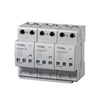The Difference Between A Surge Protective Device (spd) And A Residual Current Device (rcd)
In modern society, electricity has become an indispensable element in our daily life. In order to ensure the safe use of electrical equipment, surge protectors and leakage protectors, as key parts of the power system, have attracted much attention. This article will discuss in detail the definition, working principle and main differences between surge protectors and leakage protectors.
1. Definition and working principle of surge protectors
Surge protectors, also known as "lightning arresters", are electrical devices specially designed to protect various electronic equipment, instruments and communication lines from external interference. When the electrical circuit or communication line is disturbed by the outside world and causes a peak current or voltage, the surge protector can quickly conduct the discharge current, thereby preventing the surge from causing potential damage to other equipment in the circuit. Surge protectors are widely used in various AC 50/60HZ power supply systems, which can effectively resist indirect lightning, direct lightning effects and other transient overvoltages.
2. Definition and working principle of leakage protectors
Leakage protectors are protective devices specially designed to prevent accidents caused by electric shock and leakage. When the leakage current of a circuit or electrical equipment exceeds the set value of the device, the leakage protector can quickly cut off the power supply of the accident to prevent the accident from expanding, thereby effectively ensuring the safety of people and equipment. The working principle of the leakage protector is to detect leakage or electric shock by monitoring the zero-sequence current. When it is detected that the leakage current exceeds the set value, the leakage protector will act quickly and cut off the power supply to avoid accidents.











